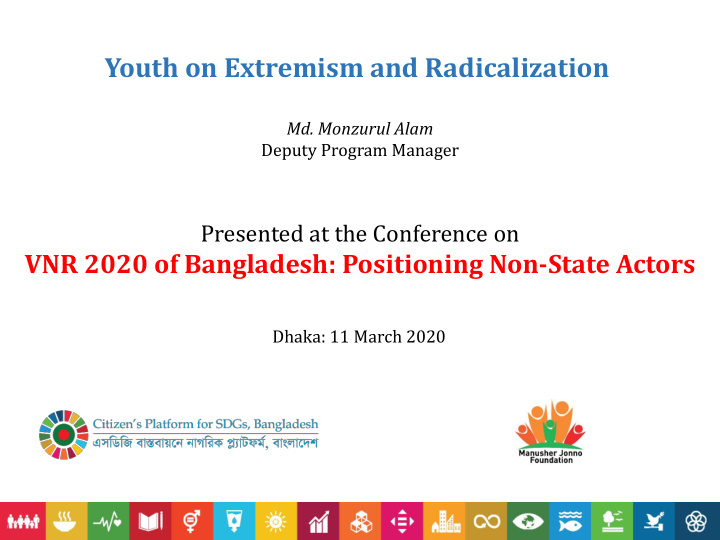



Youth on Extremism and Radicalization Md. Monzurul Alam Deputy Program Manager Presented at the Conference on VNR 2020 of Bangladesh: Positioning Non-State Actors Dhaka: 11 March 2020
Areas of Youth Potentials… • More than 33 per cent of its total population represents youth aged between 18-35 years. Contribute to Reducing Income Institutional Climate poverty inequality Many generation building action (SDG- alleviation (SDG-10) (SDG-8) (SDG-16) 13) More (SDG-1) But frustration among the youths for various Demographic dividend reasons is running the risk of emerging violent extremism
General Context • Bangladesh was ranked 31st out of 130 countries on the Global Terrorism Index 2019 • Youth unemployment rate is 8.1% while the national unemployment rate is 4.3%. (Labour Force Survey 2013) • University Graduates have highest rate of unemployment (16.4%) and the female unemployment rate of the similar group is much higher (23.5%) (BBS 2015) • Recent incidences of violent extremism also reveal the appalling situation where the involvement of youths was quite apparent • Unemployed youths are at a greater risk of radicalization. (Bhatia, K., & Ghanem, H. 2017) • 29.8 per cent young people are not involved in either education, employment or training-(The Daily Star)
History of Youth Extremism in Bangladesh- Push and Pull factors • 70’s decade: The influence of communist extremism/ terrorism, abolishing of class discrimination • 80’s decade: Islamic fundamentalism and communist extremism/ terrorism • 90’s decade: Expansion of Islamic fundamentalism and self - revelation of Harkat-ul-jihad, Jamatul Mujahidin Bangladesh, bomb attack in Udichi meeting • 2001 – 2010: Weapon using of Islamic fundamentalist, attack in Romna Batamul, attack in the meeting of communist party, attack to progressive writer and cultural activist- 2004, simultaneous 500 serious bomb attack in 63 districts, attack in government institute- 2005 • 2011 – 2018: Relationship build up/development with global extremist/ terrorist, murder of bloggers, kidnap of accused person, Holy Artisan attack _______________________________________________________________ = Ideological narratives promoting violent extremist action = limited sense of purpose = Inequality and poverty = Political violence = Ill motivation from friends and relatives = The ongoing Rohingya crisis = Drug abuse = Use of social media
Ongoing CSO interventions • Sensitization of youth and relevant stakeholders on Peace, Harmony and Violent Extremism has developed • Promotion of leadership and positive social engagement • Campaign and media mobilization for promoting counter narratives • Mobilize government functionaries to counter VE and Policy enactment • Strengthen the youth-led forums, platforms, clubs and networks • Promote youth ideas, arts, culture and sports that contribute in Social cohesion • Support local NGOs, CBOs, clubs, religious institutions, private and youth organizations • Form district-based youth platforms and a national networks on preventing youth extremism • Conduct Research and Advocacy
What MJF done ….. • Torun Alo Project of MJF reached 18,000 youth in Cox’s Bazar with 10 org including 6 CBO’s • SAMPREETI Project of MJF reached 53,614 tertiary level educated youths and their affiliates in 225 educational institutes of 6 districts through sensitizing the youth on PVE • MotherSchools Project of MJF covered number of mothers on Parenting for Peace campaign and each of them are acting as a change agent in their community • 13 partner NGOs of MJF are implementing Youth and Social Cohesion Project in 5 city corporations and 9 districts covering 22 Upazilas where 88000 youth are targeted to be an active citizen
What are the challenges??? • Communities are not ready to discuss extremism and radicalization issues • The youth feel labelled as extremist • Conservative mind-set and political influence in few geographic locations • Education institutions hesitate to allow PVE related interventions • Less interest to the youth group in involving active citizenship, leadership and volunteerism activities
Gaps in Tackling Violent Extremism • Lack of understanding on Extremism • Relationship gap within the family • Feeling isolation and exclusion from the society • Limited scope to participate in social platform, sports and extra-curricular options • Lack of proper religious interpretation • Frustration in unemployment
Recommendations • A National Plan of Action needs to be developed on PVE. • A national level platform should be formed with government agencies, donors, civil society organizations, think-tanks, academicians and youth representatives. • Gateway monitoring should be strengthened in response to the continuous radical content through social media. • In addressing violent extremism, the institutions relevant to preventing or countering should be more responsive • Government should articulate the progress of SDG Goal-16 in its next VNR. • The government should increase budgetary allocation for P/CVE.
Thank you very much for your patient hearing
Recommend
More recommend